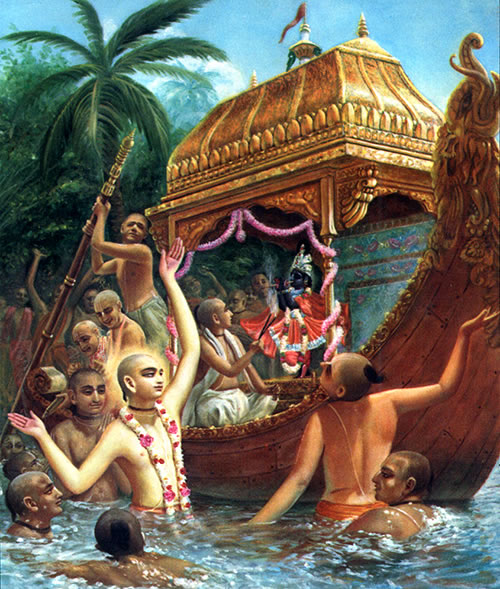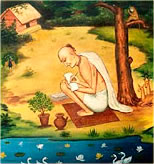How Long is a Year in
Vimsottari Mahadasa?
Page 5
1 2 3 4 5 6
How
were calendars prepared by astrologers
in
pre-British India?
Before the British introduced the Gregorian calendar to India the general public including Jyotisa Panditas all used the Lunar Calendar. There were 12 Lunar months each having 30 tithis for a total 360 tithis a year. At regular intervals, usually according to the Metonic 19 year cycle, leap months were added every 3rd, 6th, 8th, 11th, 14th, 17th and 19th year to make the Lunar year stay in phase with the Solar year. Thus if a Vedic astrologer did someone's horoscope and was tabulating the Mahadasa the years would be measured in Lunar years each of 12 months with 30 tithis in each month for a total of 360 tithis.
With the introduction of the Gregorian calendar a confusion of terminology was introduced. People who were not Panditas and knowledgeable in astronomy, time keeping and calendar making began to call the Lunar tithi as Lunar day. This Lunar day was misconstrued to be equal to a Solar day of 24 hours. This is an extremely popular misconception. I can not say how many times I have been asked about the peculiarities of the Lunar calendar. For example, I am often asked why is it that if an ekadasi took place on a certain date then why is it that next one is not 14 days later (in some instance)? Ekadasis are 11 days after the New and Full Moon, the New and Full Moon are 14 days apart, therefore the Ekadasis should also always be 14 days apart. Why has it diverged?
The problem arises because of not understanding the intricacies of the luni-solar calendar and making the very serious blunder of equating (lunar) tithi with (solar) day. A lunar tithi is not equal to a solar day, and varies in length from about 19 to 26 hours depending on the velocity of the Moon. So taking this misconception a step further, people who were not steeped in Vedic calendric tradition began thinking that since old text books and manuals used by traditional Panditas talked of years with 12 months of 30 tithis and a year of 360 tithis this must be the same as years with 12 months of 30 days and 360 day years. This, then, is how we have become entangled in a useless controversy of whether the Mahadasa should be measured in 360 day years or 365 day years. This is like comparing apple with oranges, you cannot equate a tithi with a day. By doing so you get a situation in which the two systems diverge with time.
The real question should be: can we do the mahadasa in Lunar years of 360 tithis or solar years of 365 d/y? The answer is that both are correct because both are equivalent and don't diverge. The Vedic Lunar year is actually a solar year with intercalary months inserted to keep it in phase with the seasons of the solar year.
How long was a year for Mahadasa calculations according to classical texts?
In Matresvara's classical text Phala Dipika the learned author states what length of time is a year for Mahadasa calculations:
Note the exact position of the Sun in the zodiac at the time of birth. When the Sun in the next round arrives at the same position, it is considered as one Solar year which is also the year taken for Udu Dasa system. By sub-dividing the same, days also are calculated. Phala Dipika19.4
Udu Dasa means the system of Mahadasa based on Naksatras, this includes Vimsottari and others. Now, we could have quoted this at the beginning of this discussion, but we felt obliged to present a lot more evidence to show the context of how time, calendric calculations, astrological traditions, other Vedic cultural experiences and foreign conquest combine to create an astrological controversy that should not have existed but for the lack of knowledge in Vedic cultural traditions.
Revised September 14, 2014
I recently came across this statement from Bhaskaracarya's Siddhanta-siromani, and his own Vasana commentary on the text. (From Bhaktisiddhanta's Bengali translation.) In it he clearly explains what the different standards: sauramana (solar), chandramana (lunar), savana (civil), nakshatramana (sidereal) are used for. I have edited it slightly for consistency.
"The authors of the Samhitas tell us that the year of the Jupiter (Barhaspatya Samvatsara) is measured using the mean sidereal revolution of Jupiter. The humans however use a mixture of four standards to measure time.
"The humans use solar standard to determine year, northern or southern path of a planet (ayana ), seasons and yugas. They use lunar standard for the determination of months and lunar days (tithi). The civil standard (savana) is used for the determination of special prayers (vrata), fasting (upavasa) and treatment of disease. The sidereal standard is used for the determination of ghatikas."
Siddhanta Siromani 1.30-31
"Now the Jupiter reckoning and human reckoning is stated. The first half is simple and clear."
"The human reckoning is a mixed one: year, ayana, rtu and yuga are calculated by solar. The months and tithis are calculated by lunar. Penances, fasting etc. are calculated on the basis of civil. Ghatika and so on are calculated on the basis of nakshatramana.”
Vasana Commentary 1. 30-31
So from this it becomes very clear that we should use the solar year of 365.25 days for determining the length of a year and not the savana year of 360 days. This is exactly the same as what Mantresvara is advocating in his Phala Dipika.
Does the 360 day year give "better" results than the 365 day year?
As we have shown throughout this course (which this article is an excerpt of) you can not make a judgement based on only one variable. An astrological prediction is based on weighing many factors, synthesizing them and then coming to a conclusion. To base your conclusions on only one factor, to the exclusion of all others, is the formula for failure and you will invariably go wrong. Thus, those who claim that they achieve more accuracy and get better results by using the 360 day year are ignoring the holistic approach to astrological analysis. They should not be emulated.
There will always be someone who says that they get better results by doing some un-orthodox thing like using 360 d/y, and they will waste theirs and a lot of other's time trying to prove it. This doesn't mean that I am against research in astrology but we must not forget that astrology was not developed like physics or biology, by empirical observation, it is revealed knowledge. Thus astrological research will be of a very different nature than that employed in empirical sciences. Gargamuni didn't become a master of Jyotisa by empirical research but, according to Visnu Purana, by tapasya and satisfying Anantasesa. This suggests that research in Vedic astrology should include purification of our consciousness so that we can actually understand what the Rishis have given us as well as making ourselves receptive to the words of the Paramatma, Lord Krsna within our heart. Research in Vedic studies also implies finding out the methods advocated by the Rishis and practicing them till we reach perfection. Research in Vedic Astrology doesn't mean concocting some new methods at odds with the internal logic and philosophy of the system.
No statistical study or any other method has ever been done which could prove that the 360 d/y should be applied in Vimsottari Mahadasa. Ultimately it all boils down to the "opinion" of a small group of astrologers that their method is better. If we are going to use opinion as the criteria I prefer to accept the opinion of my superior astrology teachers and great acaryas and not those of others who are unaware of Vedic cultural traditions (the material previously presented). Aside from this I can not think of any serious astrologers who use the 360 day year. All the great Panditas that I studied with, in North, East and South India all used the regular solar year of 365 days, and so do the vast, over-whelming, majority of Vedic astrologers. And that is what I recommend that you also use.

